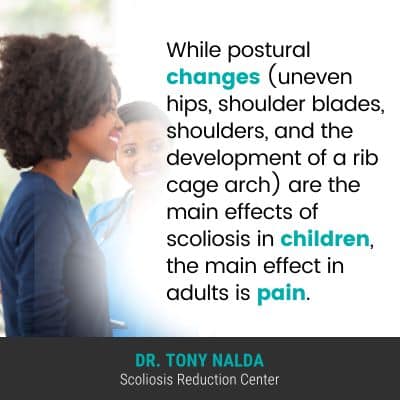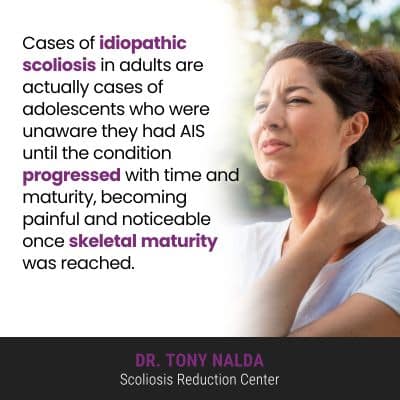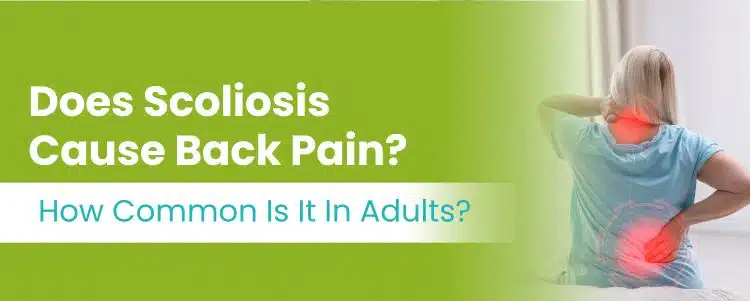Scoliosis can cause a number of effects that are felt throughout the body. When it comes to whether or not a condition is likely to be painful, this is shaped by a number of variables, condition severity, and patient age being particularly relevant when it comes to back and/or nerve pain.
Scoliosis is commonly regarded as a childhood condition, but it actually affects all ages, including adults. Adult scoliosis is more associated with back pain than childhood scoliosis because the condition doesn’t become compressive until skeletal maturity has been reached.
As no two cases of scoliosis are the same, let’s discuss the different variables that shape scoliosis symptoms.
Important Condition Variables
When scoliosis is first diagnosed, part of the process involves further specifying conditions based on key patient/condition variables; this is done to streamline the treatment process and to inform the crafting of customized treatment plans.
Conditions are classified based on patient age, condition type, severity, and curvature location, and in addition, there are also multiple curvature types and patterns that further differentiate condition effects.
The complex nature of scoliosis necessitates the customization of effective treatment plans, and this is because no two cases of scoliosis will affect the body in exactly the same way, so symptoms and effects one patient experiences don’t always indicate what others will face.
Scoliosis involves the development of an unnatural sideways-bending and rotating spinal curve, and as scoliosis is a progressive condition, the nature of scoliosis is to get worse over time.
So as we’re focusing on scoliosis pain in adult scoliosis, let’s just take a minute to explore why scoliosis doesn’t commonly cause noticeable pain and/or nerve pain in children, but does in adults.
Patient Age, Compression, and Pain
Scoliosis is most often diagnosed in children, but it also affects adults; in fact, the actual rate of scoliosis in older adults is higher than adolescent idiopathic scoliosis rates, and this is due to natural age-related spinal degeneration.
Once skeletal maturity has been reached, scoliosis becomes a compressive condition.
Compression is uneven pressure, and it’s compression of the spine and its surrounding muscles and nerves that cause the majority of condition-related pain.
Scoliosis pain can include muscle pain, localized back pain, and pain that radiates into the extremities (arm and/or leg pain) due to nerve involvement.
For children and young patients whose spines are still growing, the constant lengthening motion of growth counteracts the compressive force of the unnatural spinal curve; in fact, it’s not an uncommon scenario that adults recently diagnosed have been living with scoliosis since adolescence but didn’t receive a diagnosis until the condition became painful due to compression.
While we don’t know what triggers most cases of idiopathic scoliosis to develop, we do know what triggers progression: growth and development.
So for children who are still growing, curve progression is more likely to be rapid than in adults for whom the progressive trigger of growth has been removed, but children are also less likely to experience back and/or pinched nerves related to compression.
Condition Severity and Pain

While postural changes (uneven hips, shoulders, one shoulder blade protruding more on one side, and the development of a rib cage arch) are the main effect of scoliosis in children, the main effect in adults is pain.
Condition severity is determined by a measurement known as Cobb angle, and this is determined during X-ray and tells me how far out of alignment the spine is; the higher a patient’s Cobb angle, the more severe the condition, and the more likely it is that treatment will have to include pain relief and management.
- Mild scoliosis is diagnosed with Cobb angle measurements of between 10 and 25 degrees.
- Moderate scoliosis is diagnosed in patients with a Cobb angle measurement of between 25 and 40 degrees.
- Severe scoliosis has a Cobb angle measurement of 40+ degrees, and very-severe cases have Cobb angle measurements of 80+ degrees.
As you can see, there is a wide range of Cobb angle measurements, and the more severe a condition is, the more likely it is to continue progressing, and the more likely it is that its effects will be noticeable, including back pain.
In addition to severity, the angle of trunk rotation is also important when it comes to back pain; the more unnaturally twisted the spine is, the more painful it’s likely to be.
So now that we’ve addressed why children don’t commonly find scoliosis as painful as adults, let’s talk about the two main condition types to affect adults.
Common Types of Adult Scoliosis
The most common type of scoliosis to affect all ages is idiopathic scoliosis, meaning no known cause, and this type accounts for approximately 80 percent of known diagnosed cases, and the remaining 20 percent are associated with known causes: neuromuscular scoliosis, congenital scoliosis, and degenerative scoliosis.
Scoliosis cases associated with known causes are considered atypical; for example, cases of neuromuscular scoliosis are caused by the presence of a larger neuromuscular condition such as cerebral palsy, muscular dystrophy, and spina bifida.
Congenital scoliosis is caused by a malformed spine that develops in utero so babies are born with the condition.
Adolescent idiopathic scoliosis (AIS), diagnosed between the ages of 10 and 18, is the most prevalent type overall.
When it comes to adult scoliosis, the two main types are idiopathic scoliosis and degenerative scoliosis.
Cases of idiopathic scoliosis in adults are actually cases of adolescents who were unaware they had AIS until the condition progressed with time and maturity, becoming painful and noticeable once skeletal maturity was reached.
Pain is the number-one reason adults come to see me for a diagnosis and treatment, and the unfortunate reality is that had these patients received a diagnosis and treatment during adolescence, their spines would be in far better shape than by the time they come to see me in adulthood.
Degenerative Scoliosis

After idiopathic scoliosis, the next most common type of scoliosis to affect adults is degenerative scoliosis.
Degenerative scoliosis affects older adults, commonly 50+ years of age, and is more common in females than males due to changes in bone density and hormones related to menopause.
Degenerative scoliosis is caused by natural age-related spinal degeneration and the cumulative effect of certain lifestyle factors: carrying excess weight, leading a sedentary lifestyle, chronic poor posture, excessive consumption of alcohol and/or smoking, and repeatedly lifting heavy objects incorrectly.
The spine, like the rest of the body, is subject to degenerative changes as we age, but lifestyle factors can help shape the level and rate of age-related degenerative changes.
In most cases, it’s the spine’s intervertebral discs that are the first spinal structures to degenerate, and this is because the discs don’t have their own vascular supply, making healing difficult, and the discs also perform many roles that are key to spinal health and function.
The spinal discs give the spine structure (adjacent vertebrae attach to the disc in between), provide cushioning between adjacent vertebrae to prevent friction during activity, combine forces to facilitate spinal flexibility and act as the spine’s shock absorbers.
If a disc starts to degenerate, it commonly becomes desiccated (experiences excessive fluid loss), changes shape and loses height, and this change in the disc’s position can disrupt the positioning of adjacent vertebrae attached, disrupting the spine’s ability to maintain its natural curves and alignment.
While growth is removed in adulthood, adult scoliosis can still progress, especially once the spine has started to degenerate and become increasingly unstable and unbalanced.
Conclusion
So does scoliosis cause back pain? Scoliosis can most certainly cause back pain, but isn’t guaranteed to do so; however, when it comes to adult scoliosis, back pain that varies from mild and intermittent to chronic back pain that’s debilitating is a common effect.
So as adult scoliosis is compressive, a certain amount of back pain, and pain caused by nerve compression (pinched nerves), is to be expected; additional factors that shape the amount of back and nerve pain experienced by adults are condition severity, the amount of rotation, and type.
As degenerative scoliosis is considered an atypical type, affects older adults, and involves spinal degeneration, this type can be particularly painful as the spine becomes increasingly unstable and unbalanced alongside progression.
Regardless of age, type, or severity, the best time to start scoliosis treatment is always now; as a progressive condition, scoliosis only gets more complex to treat over time.
When it comes to adult scoliosis, the goal of treatment is to reduce the size of the unnatural spinal curvature back to where it was prior to becoming painful, to increase the spine’s support and stabilization.
When it comes to scoliosis pain, however, it’s important to understand that in order for long-term sustainable pain relief to be achieved, the underlying cause of the pain, the scoliosis itself, has to be addressed, and as a structural spinal condition, that means impacting it, first and foremost, on a structural level.




